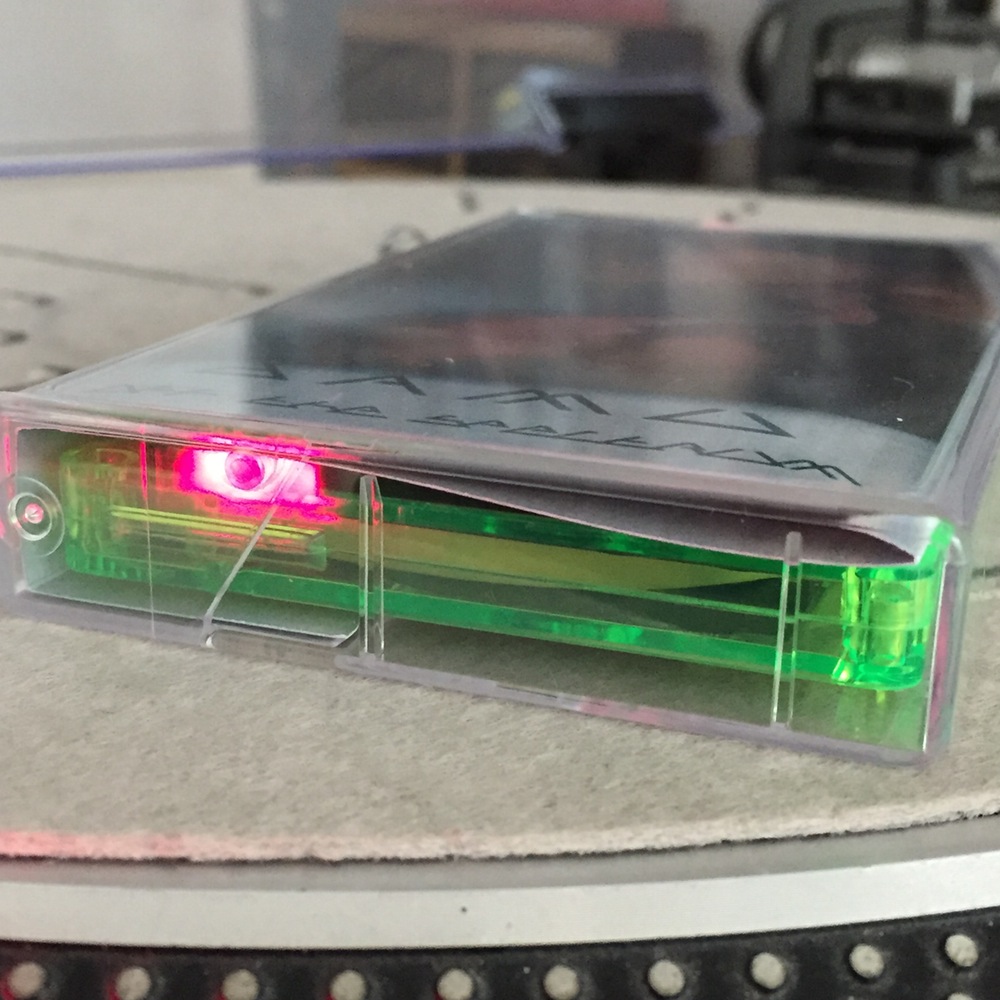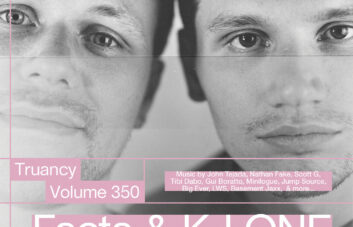Damu‘s productions have crossed boundaries and styles over the five years since his early releases, arriving on labels like Silverback and Local Action. Riding on the colourful wave of post-dubstep UK bass, his sound was bouncy and exuberant, laden with fuzzy synths and sampled vocals. An album on Keysound followed, and in the years since he’s experimented with Ikonika-esque garage as well as icy grime. Bored of making singles, he’s fashioned a long-form cassette release for Keysound that defies any expectation. Off The Spectrum features two lengthy tracks made up of vignettes, segues and ideas that drift into each other through a cascade of digital bleeps. An opening melody opens the title side, not unlike the bold vivacity of Strict Face, before collapsing into a waterfall of noise. Brandy’s vocals appear, heavily treated and chopped, “Almost Doesn’t Count” almost unrecognisable in this sparse world. Mobb Deep feature in similarly processed fashion at the top of “Point and Line to Plane”, “Shook Ones Pt II” rendered almost hilariously parodic, though it seems the sample is used with knowing reverence.
A thousand reference points trip off the tongue: Wendy Carlos, Steve Reich, Global Communication, Kuedo – all of these spring to mind as influences or aural compatriots, with the entire release feeling as much a paean to experimentation as grand artistic statement. Techno and electronica combine, with heady sonics and blank space given equal airtime. Terms like “woozy tape splodge” and “clomps” come to mind, impossible as it is to describe so much of what happens in this set, largely recorded live. Keysound’s first cassette and Damu’s largest body of work in five years dives deep into a pool of ideas and returns triumphant, its very essence spewing forth colour while gasping for air.
Leafar Legov is best known for his work as Kettenkarussell with Konstantin. However, his mixes of unreleased material suggest that he may follow the steps of comically enigmatic Traumprinz and be the next Giegling artist to blow. His recent Boiler Room session from Transylvania displays his mature, rewardingly deep talent for composing music. Legov’s main talent is his impressively rich sound design, which ranges from faded watercolours floating over the mix to suffocating dubby sweeps rumbling beneath. A combination of these sounds and tightly wound house rhythms make for an utterly hypnotic mix as it marches toward its midway peak. After the brooding, dark first half-hour, a heart-wrenchingly soulful vocal refrain, “and I love you strong,” rides in over Legov’s marvellously sinister, rolling piano-house. Following this touch of humanity, light filters down until the mix closes. Bleached pianos break through the haze and the drums syncopate more and more before falling out of 4×4 into breakbeat release. The pacing is almost perfect, mirroring the maturity shown by his unmistakeable technique in composition. All that’s needed is for Legov is to compile these gems onto a record…
Artwork, nomenclature, actual music – Nicolai Vesterkær Krog’s debut outing as Misantrop on his label Foul-Up ticked all the boxes for me. It took just 16 bars of “No. 3” (which is ironically the A1) from the recent four-tracker, Limerence, to realise this could be something special. Misantrop seems to cover all the bases when it comes to functional and intelligent listening. The opening track, along with “Nocturnal Emission” and the title track, satisfyingly blends the outskirts of house and techno. The EP finishes with a very classy, fast-paced electro workout in “They Don’t Know”. During my first listen, there was an apparent disparity in the tracks, however on revisits there proved to be a faint yet taught thread running throughout. The subtleties become transparent after relistening, but once heard, they cannot be unheard. On Limerence, Misantrop shows that the devil is truly in the detail.
meandyou.’s sixth release, the Geometry of Disorder EP by Collapsing Market co-founder Eszaid, further solidifies both the label’s and the producer’s knack for pushing techno’s boundaries. Opening the EP, “Glass Rain” falls in waves of metallic percussion. Awash in affecting synths, its haunting quality is offset by acid lines and booming bass. While a techno track in rhythm at its core, its ambient moments work to add more evocative dimensions. Caught in a storm on some faraway planet, a biting wind rips through “777’7”. Frantically sending radio transmissions to no avail, the urgency builds with the introduction of a kick drum. “Eyeless Mannekin” has a similarly pressing pace, driven by quick and cutting percussion. In dreamlike fashion, it changes course in the blink of an eye, giving way to moments of mournful pads and chest-pounding bass. Taking the dream someplace darker, “Numbers and Chaos” is slow and weighty with cavernous walls that drip as deep synths drop in and out like apprehensive footsteps. A rattlesnake shaker gives warning, creating a lasting unease. Finally, the spacious “Headcore MNS IV” clears the air with its enveloping atmosphere. Sunlight pours through stained glass windows as the collective voice of a choir reverberates off impossibly long cathedral walls. Dynamic in sound and emotional in execution, Geometry of Disorder is highlighted by moments of clarity in seeming chaos.
Willow released “Feel Me” on Workshop last year, a woozy jaunt torn between an irresistible house beat and moonlit soul/R&B singing. It proved to be the highlight from the compilation, and perhaps the ever-impressive label’s year as a whole, garnering intrigue as to what the Manchester-based DJ and producer’s next move would be. Last month saw the release of Workshop 23 – an all-Willow affair with four tracks that could undoubtedly stand out as individual singles in their own right. “A1” and “B1” are the most immediately arresting of the bunch: the former a chiming, glistening waltz through a wonky synth motif and faltering vocal samples, the latter a smooth, smart channeling of Black Mahogani that remains conscious of the past decade of UK dancefloor music. There’s an air of introspection on all tracks, manifesting in various ways just as different, glancing lights might reveal the multifaceted nature of an object. Thematically, this builds up to a closer that prioritises claps and sweeping, ambient metamorphosis over kicks. “A2” wanders in its own circle, bringing the outside world to a standstill. Interestingly, one of the EP’s most staggering moments is impossible to experience on the physical record; Willow’s seamless transition from “A2” to “B1” left me grinning for weeks.
Words by Aidan Hanratty, John Hardy, Jena Sivakuma, Taylor Trostle and Tayyab Amin.




